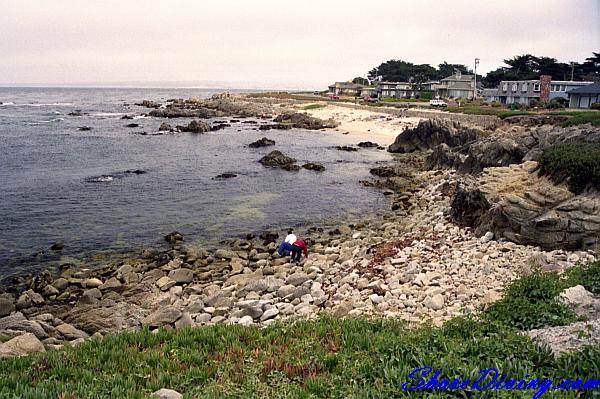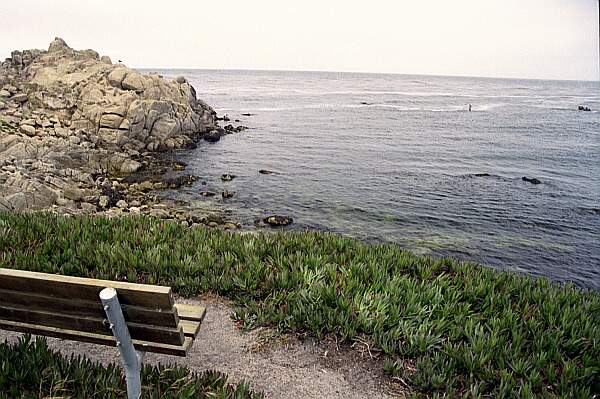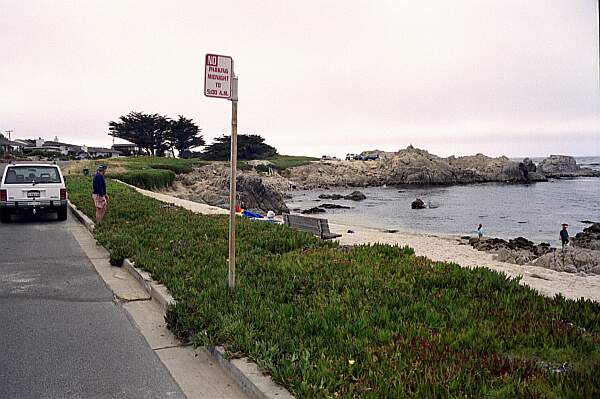Difficulty
beginner
Viz (last reported 102438h ago)
Max Depth
40 ft
Snorkeling and Scuba Diving at Coral Street Beach
Coral Street can be a technical dive if the conditions aren't just right. The kelp growth in August and September can be daunting, and the currents can catch you by surprise. Plan this dive with a dive shop, and take a buddy with you who has been here before. Do take your camera, as the macro life is spectacular! Entry can be tricky at low tide, with exposed shallow rocks and abundance of kelp and sea grasses. Once in deeper water you will find a large kelp forest fringing sand channels and walls and pinnacles. Look for remnants of John Denver's airplane.
In Monterey, heading West on Del Monte, bear right onto Lighthouse Ave, then bear right onto Foam St. Make a right onto David Ave, then a left onto Ocean View Blvd. Continue past Lover's Point Park, and about 1/2 mile beyond, you'll find the Ocean View and Coral Street intersection.
Access
shore
View
Nearby Shops
Tide Report
5
4
3
2
1
(13)
Zentacle
Sep 21, 2021, 1:04 AM
scuba
The Deep Blue is just beyond the point, so be aware of the current.
As always, be aware of rocks just under the surf line.




Johnny-Left-Coast
Apr 7, 2014, 12:00 AM
scuba
Dove Coral Street with a good buddy. It was low tide with a 4 foot west-ish swell. Being used to rocky and surfy entries, I had no problem getting out to 20ft of water. My buddy had a little harder time. 15 ft vis with lots of life out; Seals, sealions, schools of fish, game fish, whales. Pretty choppy on the surface and plenty of surge underwater. It was manageable in deeper water but I got tossed around when I went shallower. Our max depth was 50ft with a majority of our time spent at 35.
Originally posted on shorediving.com
Owen DeLong
Feb 17, 2011, 12:00 AM
scuba
Coral Street is probably my favorite cold water site of all time. It offers all the best of California diving. Multiple kelp forests, great rocks, pinnacles, and reefs, and lots of plant life. On bad days, interesting animals can be scarce. On good days, it looks like an animated fish identification poster. Seals will often join your dive and are generally friendly and playful. Otter sightings are common. Getting to the site is a beautiful drive along the coast until hounding to the beach. The road is parallel to the beach and you park literally a few feet from the water on a slightly elevated (about 3 feet) road on the inland edge of the beach. The beach from road to water is usually between 15 and 30 feet wide and not at all steep. Getting down from the road to the beach is extremely easy if unencumbered and not difficult even in full gear. Navigation is more important here than is initially apparent and it is best to make your first few trips here with someone familiar with the site. Going out, you're descending down one of a network of box canyons that widen and join as you get farther from shore. Coming back, if you pick the wrong canyon (a wrong turn at any of several forks), you can quickly find yourself in shallow surf headed into the rocks… Not a good place to be if the ocean picks up or you catch the odd tall wave. If you find yourself surrounded by rapidly rising terrain, resist the temptation to 'swim over it' and instead, reverse course to a place with more room and then surface to re-evaluate your location and your options to return to shore. The site can be a fantastic place for a night dive, but requires some greater than usual preparation. Make sure you have a way to identify your return path. Consider diving with a reel and using a line as a return guide. Having at least one qualified person as shore support is also a must in my opinion. The site can be fantastic for beginners and I have even brought open water classes here for dives 3 and 4. However, for independent diving, I would rate it intermediate. Night diving here is definitely only for experienced teams of advanced divers with good navigation skills.
Originally posted on shorediving.com
Anonymous
Dec 13, 2010, 12:00 AM
scuba
This past weekend I found myself embarking on an "intermediate-advanced" dive in the cold waters of Monterey Bay, of what I thought was beyond the skill level of a newly certified student. The conditions appeared good enough for safe diving: magicseaweed reported 3-5 foot swells, the high's were in the mid 60's, and the winds were pretty much nonexistent. Upon arriving at the dive shop, there were numerous divers suiting up everywhere and buzzing about 40+ feet visibility in Monterey Bay. For those of you unfamiliar with diving in the Pacific, this is considered a phenomenon, and I was extremely excited. We decided to attempt the shoredive out to Chase Reef from the Coral Street Beach entry, although it is recommended that one kayaks or boat dives to this destination. Our logic was to simply drop down near Coral Street Beach if we couldn't manage the surface swim out to Chase Reef. As many of you divers know the suit, the extra weights, and the conditions make the surface swim in cold water much more challenging that warm water. Still, the clear and seemingly calm waters beckoned to us, alluding us to believe we might have a chance to make it to Chase Reef. How wrong I was. As we entered the water, the visibility was amazing- well beyond 40 feet, and the swaying kelp was alluring and exciting. We trudged on, fighting our way through the kelp and outside the cove. Once outside the cove, we quickly realized that what seemed to be calm waters from the shore was a force to be reckoned with. Rolling waves pummeled at us causing a rift in distance between myself and my dive buddy until, after a while, he disappeared from my view. As water began to enter my snorkel, I found myself alone amidst the unrelenting pacific swells. Should I quit the dive, turn back, drop down, or just wait? What had happened to my dive buddy, was he ok? As a novice diver I started to panic, for I had never experienced waves so intense that I was barely able to keep my head above water. Although I had completed many, many dives in warm-water and a few dives in cold-water, I was mentally unprepared for the challenges of the pacific swells. I immediately heard the words of my dive instructor in my ear, "calm down, put your regulator on, and be ready to dump your weights." I remembered diver Dave Lieberman's story of a diver who did not release his weights and ended up a 100 feet down in Davey Jones' Locker, clutching his collection of abalone. I realized how close I was to that same fate if I didn't calm down and start making good decisions. Upon that realization, I quickly abandoned my snorkel, placed my regulator in my mouth, I proceeded to take several deep breaths until I calmed down. Once calm, I inflated my BC to maximum capacity and managed to get my head above the water just enough to catch a glimpse of my dive buddy between rolling waves. After a long swim against the waves, we were finally reunited and made the executive decision to drop down immediately to commence with a truly amazing dive. I attribute my sound judgment and good decision making skills to my instructor, who taught me well. After having failed the classroom open-water instruction, I never believed I would have been able to dive in cold-water. Looking back now, failing that course was the best thing that could have happened to me. It led me to seek out quite possibly the best instructor I have ever had, an instructor that took the time to teach me techniques that would someday save my life. Diving in cold water is a much more dangerous and challenging experience than warm-water, and I believe that good training is necessary. My suggestion for those of you who want to dive, do your homework: plan your dives, be mentally and physically prepared, and make sure you are well-trained by a good instructor.
Originally posted on shorediving.com
Shayne & Tami Holderby
Aug 29, 2010, 12:00 AM
scuba
Beautiful dive spot If conditions are right. Shallow diving, lots of surge. Rocky bottom with patches of sand. Tons of plant life. Long grass-like kelp. If your not familiar with kelp diving you're okay; it's not bull kelp, but very thin grass looking. If conditions are not flat here the dive will not be very enjoyable. The dive beach is called Rex Beach. There are no signs so just make sure you're directly across from Coral Street. No services at this beach but air and services are less than 5 minutes away.
Originally posted on shorediving.com
Al Soto
May 12, 2007, 12:00 AM
scuba
We came to dive Coral Street on a spectacular day! It was raining in San Jose but just overcast and calm with it being a low tide. The visibility was 40+ and we were able to get out to the middle reef to the left side of the channel, which is half way out to chase reef. There were a lot of fish out there, and a large monkey face eel. Just an exceptional day!
Originally posted on shorediving.com
Rich Hickey
Aug 29, 2006, 12:00 AM
scuba
Entering and exiting were a bit rough. We swam through and over the crevices created by the rocks. Once we were out about 100-150 yards it was a beautiful dive. Lots of sea grass, soft corals, kelp, small fish, but no mammals. The sun shining down through the kelp was wonderful. Good dive, but probably not the best place for a beginner like myself. Getting out with the surf was a bit tricky, and could have been pretty dangerous if the waves had gotten much larger.
Originally posted on shorediving.com
Aaron Warren
Jun 3, 2006, 12:00 AM
scuba
Got in the water at 8am with a med tide. As I went out the channel on the left side, I was meet by several sea lions and an otter. At 14' to 24' in the middle and on the right side I found one of the nicest kelp canopies I have ever seen. Lots of kelp fish. Saw some big perch in the sand areas. Lots of colors on the rock and pinnacles. Viz was 20'-25'. A very nice dive. Easy parking, no bathrooms. I stopped by Breakwater to wash off my gear. There's some pictures and a dive report @ www.kelpdiving.com
Originally posted on shorediving.com
Brian Xavier
Nov 28, 2005, 12:00 AM
scuba
Coral Street is one of my favorite dive sites. Good fish life and lots of kelp. Can sometimes be a little rough getting in, but very worth it. Go out through the channel and head north for good reef life. Take a kayak and go straight out into the kelp. Good kelp in about 30 feet of water. Have found some good gear here as well. Be careful, I once got caught in a longshore current off of Coral Street. Bought me a good pony tank the next day. Have seen many photographers taking pictures in the reefs off of Coral Street.
Originally posted on shorediving.com
Kendall Roberg
Sep 12, 2005, 12:00 AM
scuba
This was a great dive despite a fairly rough swell. Lots of fish to see and harbor seals. The huge rock formations underwater are awesome, but just be careful since you could be thrashed into one by a swell. On a very calm day this one of the best sites in Monterey. Just park on the road and use the staircase on the right side of beach to enter. Also, if you head down the road towards Lovers Point you will usually find a porta-potty or two to use. Wonderful dive when conditions are right.
Originally posted on shorediving.com
Jesse Rorabaugh
Dec 17, 2003, 12:00 AM
scuba
I have dove most of the major sites in Monterey, and this is the one I have had the most fun at. I have seen large numbers of perch, kelp rockfish, senoritas, and opaleye, as well as some Ling Cod, black, blue, and olive rockfish, cabezone, greenling, and sheephead. Occasionally harbor seals, and sea lions have followed me around here. Spearfishing is decent, at least for a beginner. Some of the larger fish I have pulled out include a 26 inch ling cod, 20 inch opaleye, 18 and inch cabezone. Both the inside, and outside sides of the kelp bed seem to be the best fishing. Also if you swim a long ways south, like a half hour swim, it seemed to get more crowded with fish.
Originally posted on shorediving.com
Tom
Apr 1, 2002, 12:00 AM
scuba
Entry and Exit are very easy at Coral Street, You need to surface swim straight out about 75 to 150 yards, Depth about 25-35 ft. Lot's of Plants and sea life. Take a light and look in the cracks and crevasses. There are seals and otters that may escort you in and out of the reefs. Coral Street is a fun place for all experience levels. One of the cool things (FREE PARKING) Bad thing (NO BATHROOMS)
Originally posted on shorediving.com
Chris Talley
Mar 2, 2002, 12:00 AM
scuba
Coral St. is a fun dive. Last time I was there there were two harbor seals and two otters in the water when we went in. You don't get very deep here, about 30 ft deep, but there is good marine life. I have seen halibut, tons of rock fish, along with plenty of perch here. I also found a small octopus in one of the tide pools after a dive.
Originally posted on shorediving.com